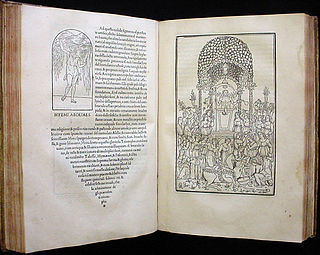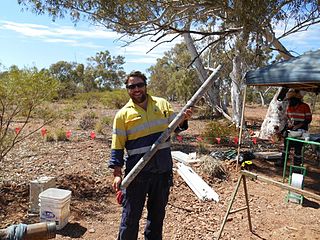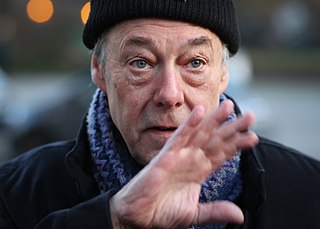External links
| General | |
|---|---|
| National libraries | |
| Art research institutes | |
| Other | |
Bernhard Edmaier is a German geologist, photographer and author of geoscientific books.
He is the main author of the illustrated book Earthsong (2005), in which he describes the Earth and its morphology from a new point of view based on pattern recognition and photographic art perspectives. The Earth's phenomena are described with respect to their genesis and to their appearance.
Edmaier studied civil engineering and geology before he switched to photography. When describing landscapes he works with aerial photographs, e.g. together with the science journalist and geologist Angelika Jung-Hüttl.
The work "Earthsong" is a spectacular collection of breathtaking aerial photographs of the Earth's surface and is divided into 4 chapters Aqua, Green, Desert and Barren. The photographs are accompanied by text and are taken all around the world from Alaska to the Bahamas and Iceland, and from continental Europe to North America and New Zealand.
The concept of an archetype appears in areas relating to behavior, historical psychology, and literary analysis.

Geomorphology is the scientific study of the origin and evolution of topographic and bathymetric features created by physical, chemical or biological processes operating at or near Earth's surface. Geomorphologists seek to understand why landscapes look the way they do, to understand landform and terrain history and dynamics and to predict changes through a combination of field observations, physical experiments and numerical modeling. Geomorphologists work within disciplines such as physical geography, geology, geodesy, engineering geology, archaeology, climatology, and geotechnical engineering. This broad base of interests contributes to many research styles and interests within the field.

Martin Parr is a British documentary photographer, photojournalist and photobook collector. He is known for his photographic projects that take an intimate, satirical and anthropological look at aspects of modern life, in particular documenting the social classes of England, and more broadly the wealth of the Western world.
Sir Richard Julian Long, is an English sculptor and one of the best-known British land artists.

Hypnerotomachia Poliphili, called in English Poliphilo's Strife of Love in a Dream or The Dream of Poliphilus, is a book said to be by Francesco Colonna. It is a famous example of an incunable. The work was first published in 1499 in Venice by Aldus Manutius. This first edition has an elegant page layout, with refined woodcut illustrations in an Early Renaissance style. Hypnerotomachia Poliphili presents a mysterious arcane allegory in which the main protagonist, Poliphilo, pursues his love, Polia, through a dreamlike landscape. In the end, he is reconciled with her by the "Fountain of Venus".

Sebastião Ribeiro Salgado Júnior is a Brazilian social documentary photographer and photojournalist.
Aerial archaeology is the study of archaeological remains by examining them from a higher altitude. In present day, this is usually achieved by satellite images or through the use of drones.

Engineering geology is the application of geology to engineering study for the purpose of assuring that the geological factors regarding the location, design, construction, operation and maintenance of engineering works are recognized and accounted for. Engineering geologists provide geological and geotechnical recommendations, analysis, and design associated with human development and various types of structures. The realm of the engineering geologist is essentially in the area of earth-structure interactions, or investigation of how the earth or earth processes impact human made structures and human activities.

Joel Meyerowitz is an American street, portrait and landscape photographer. He began photographing in color in 1962 and was an early advocate of the use of color during a time when there was significant resistance to the idea of color photography as serious art. In the early 1970s he taught photography at the Cooper Union in New York City.

Steve McCurry is an American photographer, freelancer, and photojournalist. His photo Afghan Girl, of a girl with piercing green eyes, has appeared on the cover of National Geographic several times. McCurry has photographed many assignments for National Geographic and has been a member of Magnum Photos since 1986.

Stephen Shore is an American photographer known for his images of banal scenes and objects, and for his pioneering use of color in art photography. His books include Uncommon Places (1982) and American Surfaces (1999), photographs that he took on cross-country road trips in the 1970s.

George Gerster was a Swiss journalist and a pioneer aerial photographer.
Emmet Gowin is an American photographer. He first gained attention in the 1970s with his intimate portraits of his wife, Edith, and her family. Later he turned his attention to the landscapes of the American West, taking aerial photographs of places that had been changed by humans or nature, including the Hanford Site, Mount St. Helens, and the Nevada Test Site. Gowin taught at Princeton University for more than 35 years.

Richard Leo Woldendorp AM,, is a Dutch-Australian photographer known for his aerial photography of Australian geography.
Physiographic regions of the world are a means of defining Earth's landforms into distinct regions, based upon the classic three-tiered approach by Nevin M. Fenneman in 1916, that separates landforms into physiographic divisions, physiographic provinces, and physiographic sections. Originally used in North America, the model became the basis for similar classifications of other continents, and was still considered valid as of 1951.
Ian Jeffrey is an English art historian, writer and curator.

Gerald David "Gerry" Badger is an English writer and curator of photography, and a photographer.
Chris Boot is a British photography curator, book publisher, and has worked in a variety of other roles related to photography. He was director of London’s Photo Co-op, director of the London and New York offices of Magnum Photos, editorial director at Phaidon Press, founder of Chris Boot Ltd. a photography book publisher, and is now executive director of Aperture Foundation. In these roles he has commissioned, edited or published a number of noteworthy photography books.

Timothy R. O'Neill is an American U.S. Army officer, professor and camouflage expert, responsible for designing the digital camouflage pattern MARPAT. He has been called "father of digital camouflage". O'Neill is the author of two works of fiction. In 1979 he published The Individuated Hobbit: Jung, Tolkien, and the Archetypes of Middle-Earth.
Eamonn McCabe was a British photographer. He began as a sports photographer and later worked in editorial portrait photography. Many of his portraits are held in the collection of the National Portrait Gallery, London.